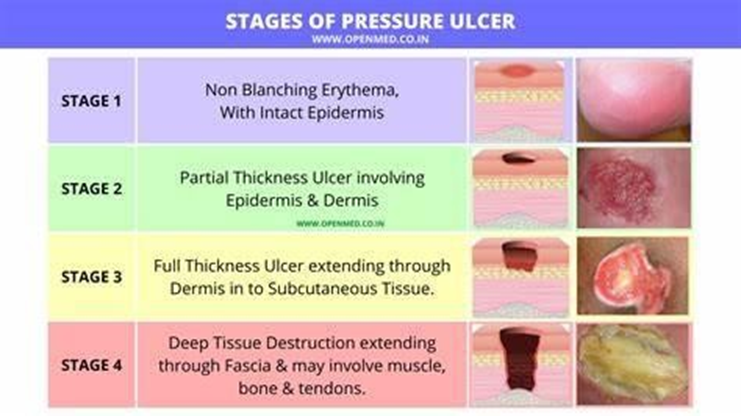The nurse observes that the tissue over the sacrum is dark, hard, and adherent to the wound edge. What is the stage for this pressure injury?
Stage IV
Stage II
Stage III
Unstageable
The Correct Answer is D
D. Unstageable pressure injuries are covered by slough (yellow, tan, gray, green, or brown) and/or eschar (tan, brown, or black) in the wound bed, making it difficult to determine the depth of tissue damage. If the wound over the sacrum is covered with dark, hard tissue that makes it impossible to visualize the depth of the wound, it could be considered unstageable
A. The description of tissue over the sacrum being dark, hard, and adherent to the wound edge suggests extensive tissue damage and possibly involvement of deeper structures like muscle or bone.
B. Stage II pressure injuries involve partial-thickness loss of skin with exposed dermis. These wounds are shallow and typically present as abrasions, blisters, or shallow ulcers.
C. Stage III pressure injuries involve full-thickness skin loss with visible adipose (fat) tissue in the ulcer. These wounds may also have undermining or tunneling.
Nursing Test Bank
Naxlex Comprehensive Predictor Exams
Related Questions
Correct Answer is D
Explanation
D. Counting the radial pulse for 30 seconds and then multiplying the count by two gives an estimate of the client's heart rate per minute (bpm). This method is efficient and commonly used in clinical practice, especially if the client's pulse is regular.
A. Counting the radial pulse for two minutes is unnecessarily long and not standard practice. Typically, the radial pulse is counted for either 30 seconds or 60 seconds (one minute) to determine the client's heart rate. Multiplying the count by two for a 30-second count or directly using the count for a 60- second count provides the client's beats per minute (bpm).
B. The radial pulse is assessed by palpating the radial artery on the thumb side (or lateral side) of the client's wrist. The nurse places the index and middle fingers gently over the radial artery and applies light pressure to feel the pulse rhythm and rate.
C. Using the thumb to count the pulse is not recommended because the thumb has its own pulse, which could interfere with accurately assessing the client's radial pulse.
Correct Answer is B
Explanation
B. This finding suggests deep tissue involvement and is characteristic of a Stage IV pressure injury. Stage IV pressure injuries involve full-thickness tissue loss with exposure of underlying structures such as bone, tendon, or muscle. This level of tissue damage requires extensive wound care and management to promote healing.

A. Thick dark eschar indicates necrotic tissue that typically covers the wound. While eschar itself is a characteristic of severe wounds, its presence alone does not define a Stage IV pressure injury. Eschar can be present in various stages of pressure injuries.
C. Partial-thickness loss of dermis typically corresponds to Stage II pressure injuries, where the injury extends into the epidermis and dermis but does not yet involve full-thickness tissue loss. This finding does not indicate a Stage IV pressure injury.
D. This finding is characteristic of a Stage III pressure injury, where the wound extends through the dermis into the subcutaneous tissue layer. In Stage IV pressure injuries, the damage progresses further to involve deeper structures such as muscle and bone, beyond the subcutaneous tissue.
Whether you are a student looking to ace your exams or a practicing nurse seeking to enhance your expertise , our nursing education contents will empower you with the confidence and competence to make a difference in the lives of patients and become a respected leader in the healthcare field.
Visit Naxlex, invest in your future and unlock endless possibilities with our unparalleled nursing education contents today
Report Wrong Answer on the Current Question
Do you disagree with the answer? If yes, what is your expected answer? Explain.
Kindly be descriptive with the issue you are facing.
